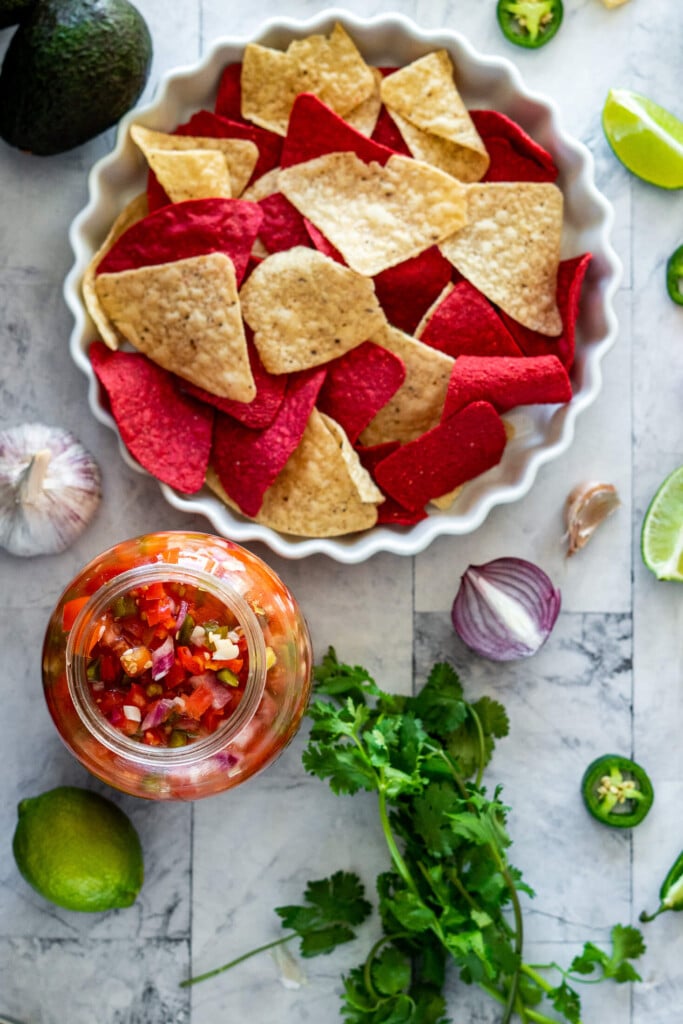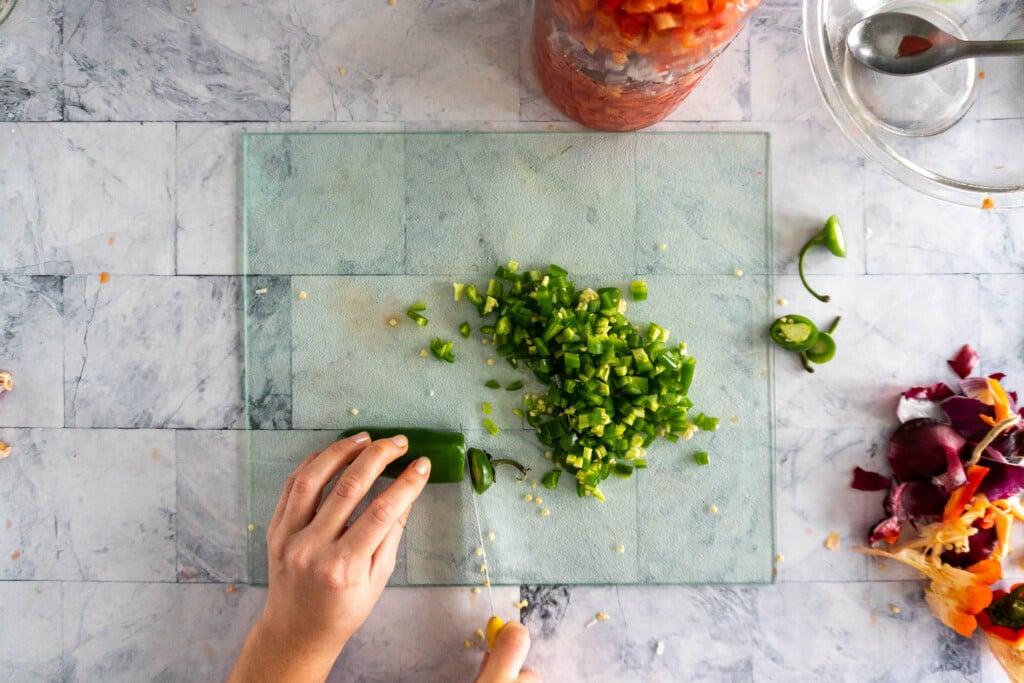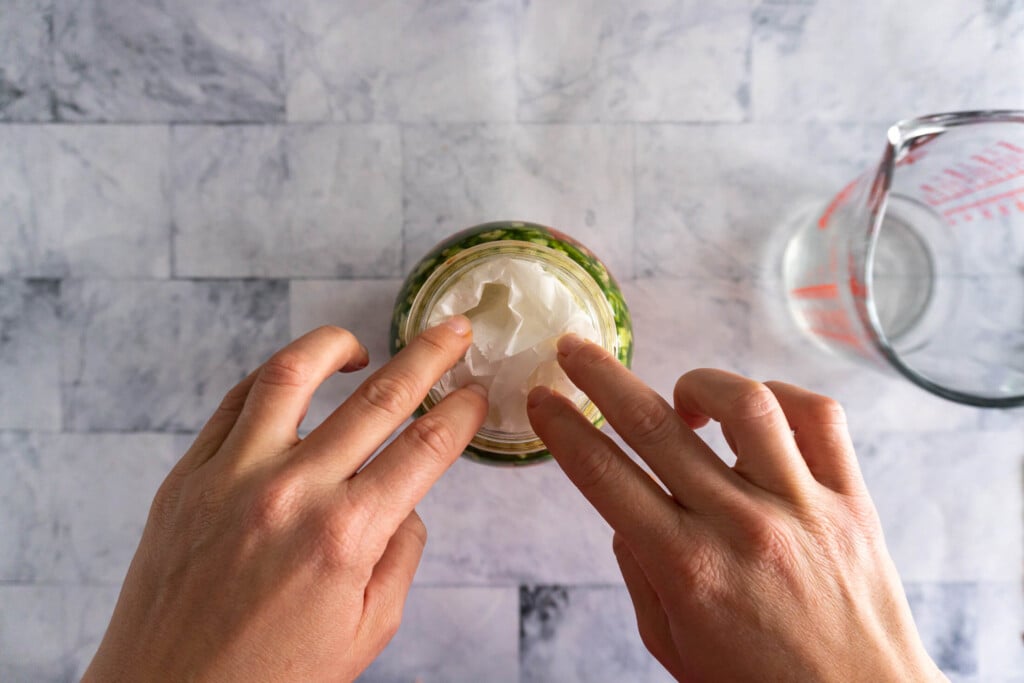Fermented Salsa
As an Amazon Associate I earn from qualifying purchases.
This fermented salsa comes together in a snap and packs a punch of tangy, zesty flavor. It’s the perfect upgrade for Taco Tuesday—and even the pickiest eaters won’t be able to stop dipping their tortilla chips! Whether you like it hot or mild, this is one recipe you’ll want to try.

Lacto Fermented Salsa
Sounds weird, but trust me on this one!
I started making fermented salsa last summer when the garden overfloweth and I couldn’t eat one more tomato sandwich, or bare to can cherry tomatoes again, or even make sun dried tomatoes once more.
Making fermented salsa involves fermenting fresh ingredients like tomatoes, jalapeños, onions, and garlic for a couple of days to create a deliciously zesty flavor. It’s delicious and easy to make, and the fermentation process adds a unique depth of flavor to your salsa. If you’re new to making fermented salsa, the key is to start with high-quality ingredients and to be patient as the flavors develop over time.
This lacto-fermented salsa recipe is dedicated to depth.
Tips
- While you’ve got the ingredients and the mess out, why not try your hand at fermented hot sauce, fermented garlic, or fermented jalapenos?
- When I talk about burping your ferment, what I mean is to open the lid and allow the carbon dioxide to escape, reducing pressure inside the jar. During the process, the live cultures in the ferment consume the peppers and other ingredients and excrete carbon dioxide which creates pressure on the jar. If left too long, the jar can burst due to pressure.
- Fermentation is a really accessible food preservation method, anyone can do it, with nearly any supplies. I have a section below detailing supplies required and easy substitutions that you’ll likely have around home!
- It is very important to ensure that ALL ingredients in the sauce remain below the brine at all times during the fermentation time – this is the best way to keep baddies at bay and prevent batch-ruining mold or other unwanted visitors to your homemade hot sauce.

What Is Lacto-Fermentation?
Lacto fermentation is a traditional food preservation method that has been used for thousands of years to preserve and enhance the flavor of foods.
It involves immersing fresh foods in salt brine, then naturally fermenting over time by good bacteria known as lactobacillus. As the fermentation process takes place, the food becomes more acidic which helps kill off any bad bacteria while preserving and enhancing the natural flavors of the ingredients.
Lacto fermentation can increase the number of probiotics in food, providing beneficial bacteria, and often the nutrients in fermented foods are more bioavailable to us.
At the end of the day, lacto-fermentation is a time-tested, versatile way to preserve food. It doesn’t just extend shelf life—it boosts flavor and adds a healthy dose of gut-friendly goodness, too.

Why Make Lacto-Fermented Salsa

Key Ingredients
Roma Tomatoes:
I prefer to use fresh Roma tomatoes when I’m making salsa or guacamole. I find that their chewier flesh makes for a better mouthfeel, that said, feel free to use any high-quality, fresh tomatoes. The better your tomatoes, the better flavor your salsa will have. Look for locally grown, in-season tomatoes for the best results. The farmers market is a great place to shop for your ingredients.
Hot Peppers:
I use jalapenos in my salsa because long after the garden has been put to bed for the season, they are readily available in my small-town grocery store! That said, feel free to use any hot pepper you like! 4 jalapenos make for a spicy salsa, so if you’re into mild salsa, I’d stick to 2.
Salt:
Choose mineral sea salt for the best flavor profile or coarse kosher salt for the most neutral salt flavor.
Water:
Spring water or well water works great in fermenting recipes. Avoid chlorinated water wherever possible as chlorine can affect microbial activity. I use straight well water or well water run through my RO system for all my ferments.

How To Make Fermented Salsa
Prepare Ingredients:
- Prepare for fermenting by washing a fermentation vessel, which can be as simple as a mason jar and lid. It does not have to be sanitized or sterilized but should be washed well with hot soapy water. Set aside to dry. Wash fresh ingredients under warm running water.
- Coarsely dice 8-10 Roma tomatoes, then toss them in a large bowl with 1 tablespoon of salt.
- Continue dicing the remaining ingredients, 2 medium red onions, 2 red bell pepper, 4 jalapeno pepper, and 4-6 cloves of garlic. Toss all diced ingredients together.
- Transfer to a half-gallon mason jar or 2 one quart jars.






Prepare The Brine:
- Combine 2 cups of water with 1 tablespoon of sea salt. Stir until completely dissolved.
- Pour salt brine into the fermentation vessel until everything is covered.
- Weigh down the ingredients before securing the lid tightly.
- Set it aside to ferment.



Ferment The Salsa:
- Keep your ferment somewhere where you’ll see it daily to observe and open the lid and burp it but keep it away from direct sunlight. If you’re using an airlock lid or pickle pipe, you won’t need to burp the jar.
- After 24 hours, you should start to notice fermenting activity. There will be small bubbles that rush to the top of the jar when you tap it, the jar may hiss slightly when opened, the color of the ingredients will dull, the brine will be cloudy, and the brine may leak over the top of the jar and run down the sides.
- Allow the salsa to ferment for 2-4 days, tasting it each day until you find the perfect finished product for your preferences.
- Once you’re satisfied with the salsa’s flavor it’s time to halt the fermentation. Either transfer the contents of the jar to the fridge or cold room held around 37f or 4c. The fermentation process will continue at these temperatures but it will be drastically reduced.


Recipe Notes
The recipe recommends tossing all of the fresh vegetables in a large bowl prior to adding them to the fermentation vessel, for the photos, I have layered them and tossed them after the fermentation process, both work, I just love to look at the layers while it’s fermenting!
Finishing:
This salsa is delicious as is at the end of the fermentation process but feel free to play around and toss in some fresh cilantro or add a squirt of lime juice. Like cumin? Toss in a pinch. Make this the best salsa you’ve ever had according to your taste buds!
Fermenting Time:
The great thing about fermenting anything is that it’s all about personal taste, and there’s no right or wrong answer when it comes to fermentation time. Most people ferment their sauce for 2-4 days, but you can certainly ferment for longer if you want to develop a deeper, more complex flavor.
The key is to experiment and find what works best for your taste buds. If you’re new to fermented food, start with a shorter fermentation time and then taste your salsa each day to see how it’s developing. If you like what you taste, then you can halt the fermentation and enjoy it. But if you want a deeper flavor, then you can ferment for a little longer next time.
Ultimately, the decision of how long is entirely up to you, so have fun and experiment until you find the perfect flavor profile for your taste buds.
Fermenting Temperature:
The ideal range for fermentation is between 68-75°F.
If the temperature is too low, the fermenting process will take longer and may not be as effective. On the other hand, if the temperature is too high, the fermentation process will occur too quickly and may produce an unpleasant flavor.
Fermenting your salsa at the right temperature will ensure that it has a bold, flavorful taste that everyone will love.
Kahm Yeast:
If you notice a white film forming on the surface of your ferment, it’s more than likely kahm yeast – which is generally harmless but tastes terrible.
The presence of kahm yeast will probably affect the outcome of your salsa – though some people say you can scrape it off and continue, I’d advise you to scrap it and start again.
While it may be tempting to try and salvage your salsa, it’s generally not worth the risk. Starting over may seem like a pain, but it’s better than ending up with a batch that’s inedible.

Batch + Storage
Batch:
This recipe as written fills a half-gallon mason jar nearly to the rim. By the end of the fermentation process, the contents do settle as the liquid is released from their cells, but the volume remains the same.
This recipe is easy to double or halve, just keep the ratios the same!
Storage:
Keep your delicious homemade salsa in the fridge for up to 2 months – if it even lasts that long!
The microbes in your salsa are still alive and viable, and they’ll continue to create carbon dioxide. If kept at room temperature, you’ll be likely to create a salsa explosion – and not in a good way. Please, please, keep it in the fridge or cold storage for long-term storage.
Fermentation Supplies Required
As previously mentioned, fermentation is very accessible – it doesn’t require any specialized equipment.
Fermentation vessel: This can be any glass jars that have airtight lids. A mason jar, an old pickle jar, an old kombucha bottle. Anything you have around will certainly work! It just needs to be airtight and glass. Non-glass materials can be porous and difficult to clean, and/or harbor bad microbes.
Fermentation weight: While there are specific glass fermentation weights or pickle pebbles, you can use a few different things. A ziplock-style bag half filled with brine placed on top of the ingredients works great. A crumpled piece of parchment paper placed on top of the ingredients also works.
I have airlock lids and pickle pipes as well as glass fermentation weights here in the Crave kitchen, but I also don’t have enough of them to keep me in the ferments, SO I often end up using other things from around the house and they work just fine!
Shop This Recipe!
 Buy Now →
Buy Now →  Buy Now →
Buy Now →  Buy Now →
Buy Now → I’ll send the ingredients and instructions straight to your inbox!
📖 Printable Recipe

Fermented Salsa
Ingredients
- 8 to 10 roma tomatoes
- 2 medium red onions
- 2 red bell peppers
- 2 to 4 jalapeno peppers depending on taste
- 4 to 6 garlic cloves
- 2 tablespoons salt divided
- 2 cups water room temperature
Instructions
Prepare Ingredients:
- Prepare for fermenting by washing a fermentation vessel. It does not have to be sanitized or sterilized but should be washed well with hot soapy water. Set aside to dry. Wash fresh ingredients under warm running water.
- Coarsely dice 8-10 Roma tomatoes, then toss them in a large bowl with 1 tablespoon of salt.
- Continue dicing ingredients, 2 medium red onions, 2 red bell pepper, 4 jalapeno pepper, and 4-6 cloves of garlic. Toss all diced ingredients together.
- Transfer to a half-gallon mason jar or 2 one quart jars.
Prepare The Brine:
- Combine 2 cups of water with 1 tablespoon of sea salt. Stir until completely dissolved.
- Pour salt brine into the fermentation vessel until all ingredients are covered.
- Weigh down the ingredients before securing the lid tightly.
- Set it aside to ferment.
Ferment The Salsa:
- Keep your ferment somewhere where you'll see it daily to observe and open the lid and burp it but keep it away from direct sunlight. If you're using an airlock lid or pickle pipe, you won't need to burp the jar.
- After 24 hours, you should start to notice fermenting activity. There will be small bubbles that rush to the top of the jar when you tap it, the jar may hiss slightly when opened, the color of the ingredients will dull, the brine will be cloudy, and the brine may leak over the top of the jar and run down the sides.
- Allow the salsa to ferment for 2-4 days, tasting it each day until you find the perfect finished product for your preferences.
- Once you're satisfied with the salsa's flavor it's time to halt the fermentation. Either transfer the contents of the jar to the fridge or cold room held around 37f or 4c. The fermentation process will continue at these temperatures but it will be drastically reduced.
Notes
Finishing:
This salsa is delicious as is at the end of the fermentation process, but feel free to play around and toss in some fresh cilantro or add a squirt of lime juiceFermenting Time:
The great thing about fermenting anything is that it's all about personal taste, and there's no right or wrong answer when it comes to fermentation time. Most people ferment their sauce for 2-4 days, but you can certainly ferment for longer if you want to develop a deeper, more complex flavor. The key is to experiment and find what works best for your taste buds. If you're new to fermented food, start with a shorter fermentation time and then taste your salsa each day to see how it's developing. If you like what you taste, then you can halt the fermentation and enjoy it. But if you want a deeper flavor, then you can ferment for a little longer next time.Fermenting Temperature:
The ideal range for fermentation is between 68-75°F. If the temperature is too low, the fermenting process will take longer and may not be as effective. On the other hand, if the temperature is too high, the fermentation process will occur too quickly and may produce an unpleasant flavor.Kahm Yeast:
If you notice a white film forming on the surface of your ferment, it's more than likely kahm yeast – which is generally harmless but tastes terrible. The presence of kahm yeast will probably affect the outcome of your salsa – though some people say you can scrape it off and continue, I'd advise you to scrap it and start again. While it may be tempting to try and salvage your salsa, it's generally not worth the risk. Starting over may seem like a pain, but it's better than ending up with a batch that's inedible.Batch:
Storage:
Keep your delicious homemade salsa in the fridge for up to 2 months – if it even lasts that long! The microbes in your salsa are still alive and viable, and they'll continue to create carbon dioxide. If kept at room temperature, you'll be likely to create a salsa explosion – and not in a good way. Please, please, keep it in the fridge or cold storage for long-term storage.Recommended Equipment + Ingredients
Nutrition
Pin This Fermented Salsa Recipe!















Once anything is fermented to your liking or taste, can you then freeze it or can it for longer storage? Or do either change the taste because the cultures are killed off?
Hey Dana, I think freezing would change the texture and it may not be appealing afterwards, BUT you can store it in the fridge for at least a few weeks, maybe even longer! My mom had a huge jar I gifted her that lasted her months lol